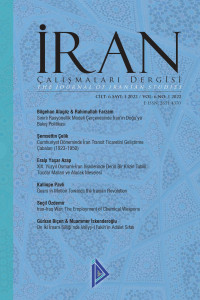Öz
Anahtar Kelimeler
Qajar Shiite Rituals and Customs Pahlavi Poverty Iranian Revolution
Destekleyen Kurum
Panteion University of Social and Political Sciences
Kaynakça
- Abdi, K. (2001). Nationalism, politics, and the development of archaeology in Iran. American Journal of Archaeology, 105(01), 50-76. https://doi.org/10.2307/507326
- Abrahamian, E. (1982). Iran between two revolutions. Princeton University Press.
- Abrahamian, E. (2008). A history of modern Iran. Cambridge University Press.
- Aghaie, K.S. (2004). The martyrs of Karbala Shi'i symbols and rituals in modern Iran. University of Washington Press.
- Amanat, M. (2012). Set in stone: Homeless corpses and desecrated graves in modern Iran. International Journal of Middle East Studies, 44(02), 257-283. https://doi.org/10.1017/S0020743812000049
- Amirahmadi, H. (2012). The political economy of Iran under the Qājārs. I.B. Tauris.
- Avery, P., Hambly, G.R.G., & Melville, C.P. (2008). The Cambridge history of Iran. Cambridge University Press.
- Axworthy, M. (2013). Revolutionary Iran. A history of the Islamic Republic. Oxford University Press.
- Balslev, S. (2019). Iranian masculinities: Gender and sexuality in late Qājār and early Pahlavi Iran. Cambridge University Press.
- Cole, J. (1999). Religious dissidence and urban leadership: Bahais in Qajar Shiraz and Tehran. Journal of the British Institute of Persian Studies, 37, 123-142. https://www.jstor.org/stable/4299998
- Donovan, M. (1997). National intelligence and the Iranian revolution. Intelligence and National Security, 12 (1), 143-163. https://doi.org/10.1080/02684529708432403
- Floor, W. (1976). The merchants (tujjār) in Qājār Iran. Zeitschrift Der Deutschen Morgenländischen Gesellschaft, 126 (1). https://www.jstor.org/stable/43381673
- Foran, J. (1989). The concept of dependent development as a key to the political economy of Qājār Iran (1800-1925). Iranian Studies, 22(2/3), 5-56. https://doi.org/10.1080/00210868908701730 Iran: The Show of Shows. (1971, October 25). TIME.
- Jenkins, J. (2016). Iran in the Nazi new order, 1933–1941. Iranian Studies, 49(5), 727-751. https://doi.org/10.1080/00210862.2016.1217636
- Keddie, N. (1966). Religion and rebellion in Iran. Frank Cass and Company.
- Loftus, W. K. (1857). Travels and researches in Chaldaea and Susiana. James Nisbet and Company Publisher.
- McBeth, B.S. (1985). British oil policy 1919-1939. Frank Cass and Company.
- Okazaki, S. (1986). The great Persian famine of 1879-71. Bulletin of the School of Oriental and African Studies, 49(1), 183-192. https://doi.org/10.1017/S0041977X00042609
- Price, M. (2005). Iran's diverse peoples. ABC-CLIO.
- Rieffer-Flanagan, B. (2013). Evolving Iran an introduction to politics and problems in the Islamic Republic. Georgetown University Press.
- Sykes, P. M. (1915). History of Persia. MacMillan and Company.
- Wilber, D. (1981). Iran, past and present: From monarchy to Islamic Republic. Princeton University Press.
- Wilber, D. (2006). Regime change in Iran: Overthrow of premier Mossadeq of Iran, November 1952 -August 1953. Spokesman.
Öz
Anahtar Kelimeler
Kaçar Şii Ritüelleri ve Gelenekleri Pehlevi Yoksulluk İran Devrimi
Kaynakça
- Abdi, K. (2001). Nationalism, politics, and the development of archaeology in Iran. American Journal of Archaeology, 105(01), 50-76. https://doi.org/10.2307/507326
- Abrahamian, E. (1982). Iran between two revolutions. Princeton University Press.
- Abrahamian, E. (2008). A history of modern Iran. Cambridge University Press.
- Aghaie, K.S. (2004). The martyrs of Karbala Shi'i symbols and rituals in modern Iran. University of Washington Press.
- Amanat, M. (2012). Set in stone: Homeless corpses and desecrated graves in modern Iran. International Journal of Middle East Studies, 44(02), 257-283. https://doi.org/10.1017/S0020743812000049
- Amirahmadi, H. (2012). The political economy of Iran under the Qājārs. I.B. Tauris.
- Avery, P., Hambly, G.R.G., & Melville, C.P. (2008). The Cambridge history of Iran. Cambridge University Press.
- Axworthy, M. (2013). Revolutionary Iran. A history of the Islamic Republic. Oxford University Press.
- Balslev, S. (2019). Iranian masculinities: Gender and sexuality in late Qājār and early Pahlavi Iran. Cambridge University Press.
- Cole, J. (1999). Religious dissidence and urban leadership: Bahais in Qajar Shiraz and Tehran. Journal of the British Institute of Persian Studies, 37, 123-142. https://www.jstor.org/stable/4299998
- Donovan, M. (1997). National intelligence and the Iranian revolution. Intelligence and National Security, 12 (1), 143-163. https://doi.org/10.1080/02684529708432403
- Floor, W. (1976). The merchants (tujjār) in Qājār Iran. Zeitschrift Der Deutschen Morgenländischen Gesellschaft, 126 (1). https://www.jstor.org/stable/43381673
- Foran, J. (1989). The concept of dependent development as a key to the political economy of Qājār Iran (1800-1925). Iranian Studies, 22(2/3), 5-56. https://doi.org/10.1080/00210868908701730 Iran: The Show of Shows. (1971, October 25). TIME.
- Jenkins, J. (2016). Iran in the Nazi new order, 1933–1941. Iranian Studies, 49(5), 727-751. https://doi.org/10.1080/00210862.2016.1217636
- Keddie, N. (1966). Religion and rebellion in Iran. Frank Cass and Company.
- Loftus, W. K. (1857). Travels and researches in Chaldaea and Susiana. James Nisbet and Company Publisher.
- McBeth, B.S. (1985). British oil policy 1919-1939. Frank Cass and Company.
- Okazaki, S. (1986). The great Persian famine of 1879-71. Bulletin of the School of Oriental and African Studies, 49(1), 183-192. https://doi.org/10.1017/S0041977X00042609
- Price, M. (2005). Iran's diverse peoples. ABC-CLIO.
- Rieffer-Flanagan, B. (2013). Evolving Iran an introduction to politics and problems in the Islamic Republic. Georgetown University Press.
- Sykes, P. M. (1915). History of Persia. MacMillan and Company.
- Wilber, D. (1981). Iran, past and present: From monarchy to Islamic Republic. Princeton University Press.
- Wilber, D. (2006). Regime change in Iran: Overthrow of premier Mossadeq of Iran, November 1952 -August 1953. Spokesman.
Ayrıntılar
| Birincil Dil | İngilizce |
|---|---|
| Bölüm | Makaleler |
| Yazarlar | |
| Yayımlanma Tarihi | 30 Haziran 2022 |
| Yayımlandığı Sayı | Yıl 2022 Cilt: 6 Sayı: 1 |
Creative Commons License
This work is licensed under a Creative Commons Attribution-NonCommercial 4.0 (CC BY NC) International License.
İran Çalışmaları Dergisi bilginin yayılması ve zenginleşmesi için Açık Erişim Politikasına uymaktadır.


